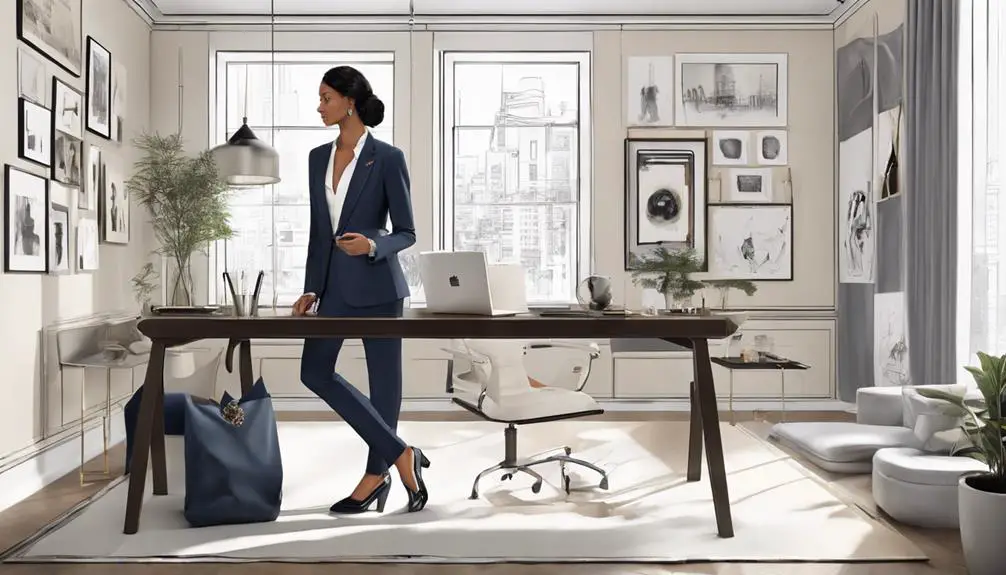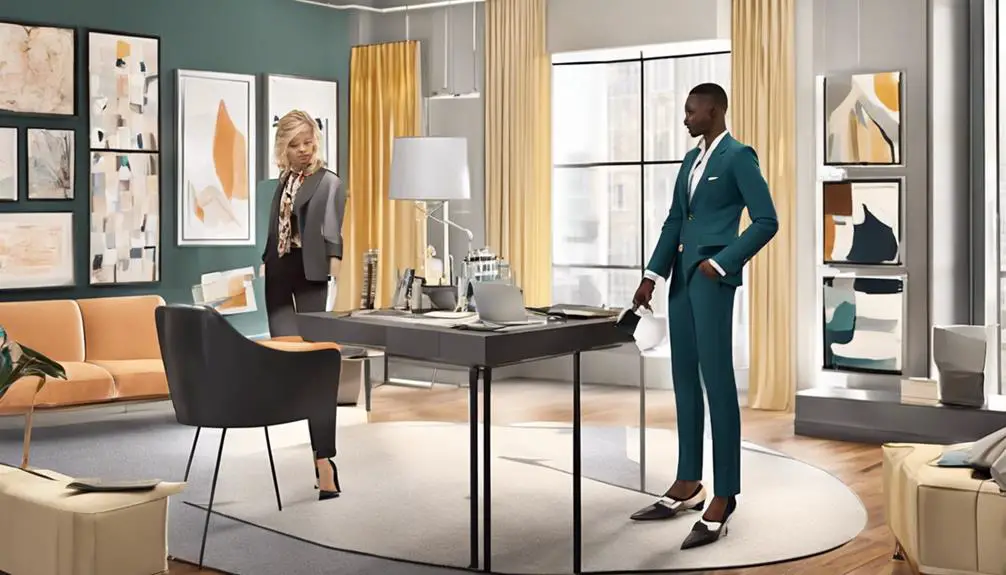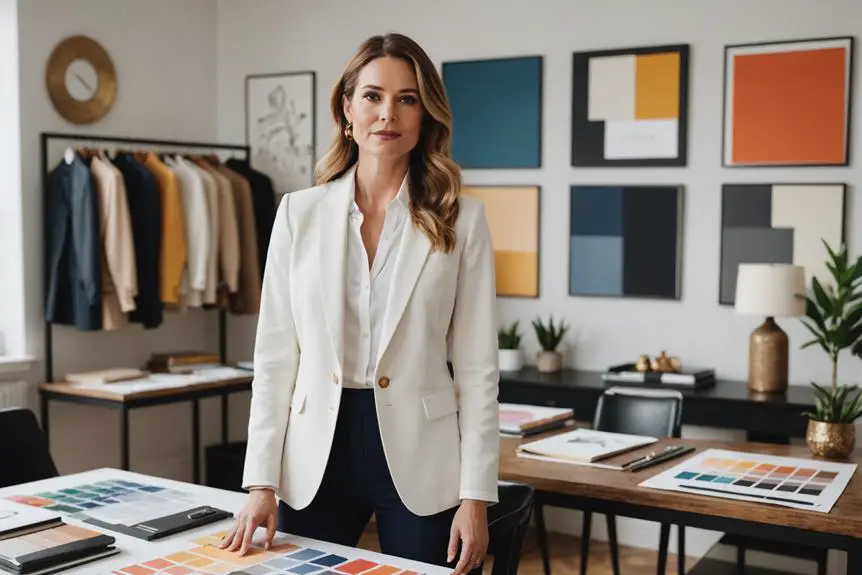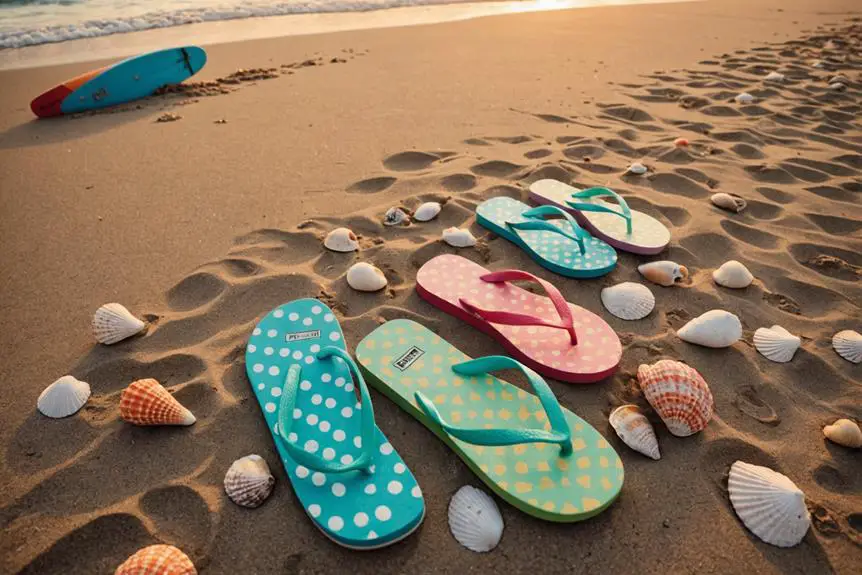Dressing as an interior designer means striking the perfect balance between style and professionalism. You'll want to invest in tailored blazers and crisp white shirts that exude sophistication while allowing you to express your unique design sensibility. Comfortable yet chic flats or low heels are essential for long hours, especially during client meetings. Don't shy away from statement accessories; they can elevate a simple outfit and showcase your personality. As you adapt your wardrobe seasonally, remember that layering is key. Embracing these tips will enhance your professional image and boost your confidence, and there's even more to explore about this exciting journey.
Importance of Professional Attire

When you step into the world of interior design, the importance of professional attire can't be overlooked. Your clothing choices greatly influence how clients perceive you, establishing trust and confidence in your abilities. A polished appearance not only enhances your professional image but also acts as a walking advertisement for your brand. Imagine walking into client meetings, dressed in quality pieces that reflect your design sensibility—it's an instant icebreaker and conversation starter! Incorporating tailored pieces, such as a Vintage Clothing Guides blazer or trousers, can elevate your look while showcasing your attention to detail.
Dressing appropriately for various work environments, from bustling job sites to elegant client meetings, is essential. You want to strike that perfect balance between comfortable yet stylish. Think about building a wardrobe of neutral basics; these versatile pieces can be mixed and matched effortlessly, giving you the flexibility to adapt to any situation. Tailored clothing made from high-quality fabrics not only looks great but also demonstrates your commitment to professionalism.
Moreover, your attire can positively affect your body language and overall confidence. When you dress for success, you radiate assurance, which is vital for engaging effectively with clients and industry professionals. They'll notice your attention to detail, and it'll resonate with your design philosophy. Ultimately, wearing suitable attire is more than just about looking good; it's about creating a strong first impression and nurturing lasting relationships in the interior design field. So, embrace the power of professional attire, and let it elevate your career to new heights!
Essential Wardrobe Pieces
Creating a well-rounded wardrobe is essential for any aspiring interior designer. You'll want to curate a classic capsule wardrobe that combines both style and functionality, perfect for your interior design projects. Start with tailored blazers; these are key pieces that provide a polished look, making them versatile for both client meetings and site visits. Consider adding vintage elements, such as a tailored varsity jacket, which can add a unique touch to your outfits while ensuring comfort and ease of movement. Pair them with smart trousers or tailored skirts, ensuring you have a professional yet comfortable option that allows for ease of movement throughout your day.
Next, don't forget the crisp white shirts. These timeless staples add sophistication and professionalism to any outfit, instantly elevating your appearance. When it comes to footwear, opt for stylish flats or low heels. They'll keep you comfortable during those long hours on your feet while still maintaining a chic vibe.
To add personality to your outfits, incorporate statement accessories. Bold necklaces or unique scarves can enhance your look, reflecting your individuality without overwhelming your ensemble. These pieces can transform a simple outfit into a stylish statement, showcasing your flair for design.
Dressing for Client Interactions

When you're dressing for client interactions, remember that your appearance speaks volumes about your professionalism. Opting for tailored outfits not only enhances your image but also adapts well to various meeting settings, ensuring you always look polished and prepared. By balancing sophistication with a touch of creativity through your accessories, you'll leave a lasting impression that builds client confidence in your design abilities.
Professional Appearance Matters
A polished appearance plays an essential role in establishing your credibility as an interior designer during client interactions. When you dress in tailored pieces like blazers or structured dresses, you convey professionalism that builds trust with your clients. First impressions are critical, and a polished outfit can greatly affect their confidence in your abilities and project outcomes.
Opt for a neutral color palette that allows your unique accessories to shine without overwhelming your professional appearance. This balance not only showcases your creativity but also maintains a sophisticated image. When attending client presentations, make sure your footwear is comfortable yet stylish. Low-heeled boots or supportive loafers will keep you looking sharp while accommodating those long hours of meetings.
Don't overlook grooming, either. A neat hairstyle and minimal makeup complement your attire and reinforce your commitment to a polished appearance. By focusing on these details, you'll create an inviting atmosphere that encourages open communication and collaboration. Remember, your appearance speaks volumes before you even say a word, so make every interaction count by dressing for success. With the right choices, you'll not only impress but also inspire confidence in your design expertise!
Outfit Adaptability for Meetings
Outfit adaptability is key for interior designers maneuvering client interactions, as meetings can shift from casual discussions to more formal presentations in an instant. To guarantee you're always prepared, build a classic capsule wardrobe of neutral basics that allows for easy mixing and matching. This way, you can create polished looks on short notice that reflect your professionalism and style.
Incorporate smart-casual attire, such as tailored blazers over fitted tops, to convey confidence and sophistication. These adaptable outfits serve as the perfect foundation for various meeting types. Pair them with comfortable yet stylish footwear, allowing you to move easily during site visits while maintaining a professional appearance.
Don't underestimate the power of statement accessories! They can elevate even the simplest outfit, adding a touch of personality without being overly distracting. Embrace pieces that resonate with your style and help you stand out in the best way possible.
Home Office Outfit Tips
Dressing for your home office doesn't have to be a chore; instead, it can reflect your personal style while keeping comfort in mind. Embrace the casual yet professional vibe that many interior designers enjoy when working from home. Start with comfortable jeans paired with a stylish jumper for those days without client meetings. This effortlessly blends ease with a hint of flair, allowing you to stay focused and productive. Consider adding a well-fitted wool coat for those chillier days, as wool coats combine warmth and elegance, making them perfect for a cozy home office environment.
When it's time for virtual meetings, swap out your casual top for a polished, professional shirt or a chic cashmere sweater. This will convey a sophisticated image even if you're still rocking those cozy bottoms. Layering is key, so add a tailored blazer or a chic jacket to elevate your look instantly, ensuring you're always prepared for unexpected video calls or client interactions.
Remember, breathable fabrics are your best friends, especially during long hours spent at your desk. Opt for neutral tones that can easily mix and match with your existing wardrobe. Stylish shoes can tie your outfit together—think sleek loafers or trendy flats that keep your feet feeling good while looking sharp.
Maintaining a tidy and professional appearance in your home office not only enhances your confidence but also showcases your design sensibility in a casual setting. So, embrace the art of dressing for your home office; it's all about balancing comfort with that hint of professionalism that reflects who you are as an interior designer.
Seasonal Style Adaptations

Adapting your style to the seasons can elevate your wardrobe while keeping you comfortable and professional. As an interior designer, embracing seasonal style adaptations is key to looking polished and guaranteeing you're ready for any project. Start with layering for weather variability; in shifting seasons, light blazers paired with breathable fabrics like cotton or linen allow for warmth without bulk.
Next, consider seasonal color palettes. Incorporating pastels in spring and deeper tones in fall will refresh your wardrobe, aligning it with current trends while reflecting the vibrant energy of each season.
When it comes to fabric choices for comfort, choose lightweight, breathable materials for warmer months and heavier fabrics like wool or cashmere in winter. This guarantees you maintain comfort without sacrificing style.
Footwear adaptations are equally important. Shift from stylish sandals in summer to chic ankle boots in fall, allowing you to keep up professionalism and comfort suited to different job settings, whether you're on-site or meeting a client.
Lastly, let's visualize your seasonal style with the following table:
| Season | Outfit Element | Key Features |
|---|---|---|
| Spring | Light Blazer | Cotton, pastel colors |
| Summer | Breezy Tops | Lightweight fabrics |
| Fall | Cozy Sweaters | Wool, deeper tones |
| Winter | Stylish Outerwear | Cashmere, layering |
| Year-Round | Versatile Footwear | Sandals to ankle boots |
Accessorizing for Impact
Accessorizing can truly elevate your look, so don't underestimate the power of statement pieces like bold necklaces or vibrant blazers that capture attention while keeping things professional. Layering accessories also offers versatility, allowing you to adapt your style for different settings and temperatures—think chic scarves that add flair and functionality. Remember, the right mix of edgy and feminine touches can not only showcase your unique aesthetic but also reflect your keen design sensibility.
Statement Accessories Impact
Statement accessories can truly elevate your outfit, making it a reflection of your unique style as an interior designer. Whether it's a bold statement necklace or oversized earrings, these pieces transform a simple ensemble into a standout look that showcases your creativity. On work days, consider incorporating colorful blazers or distinctive handbags that serve as eye-catching elements, drawing attention while you navigate meetings and client consultations.
The key is to select accessories that complement your outfit without overwhelming it, allowing your personality to shine through. When you wear neutral tones, for instance, a vibrant accessory can create a striking contrast, making you feel confident and polished. Remember, interior designers wear accessories as a means of self-expression, reinforcing their brand identity through thoughtful choices.
Opt for comfortable yet stylish items that reflect your design sensibility. A carefully chosen accessory not only enhances your overall presentation but also communicates your professional ethos. So don't shy away from making bold choices; your statement accessories can become a powerful tool in defining your unique aesthetic in the world of interior design.
Layering for Versatility
In the world of interior design, layering offers you the flexibility to adjust your look for different settings, effortlessly moving between client meetings and job sites while keeping a polished appearance. The key is to create a versatile outfit that shifts smoothly throughout your day. Here are four essentials to evaluate when layering:
- Tailored Blazer: This piece instantly elevates any outfit, transforming a casual top into a professional ensemble without sacrificing comfort.
- Versatile Base Pieces: Opt for well-fitted dresses or tailored trousers, which serve as a solid foundation for your capsule wardrobe, allowing for endless layering possibilities.
- Statement Accessories: Incorporate scarves or bold necklaces to inject personality into your layered outfits, making a memorable impression.
- Temperature-Adaptable Layers: Choose lightweight, removable layers that can be added or taken off with ease, ensuring you're comfortable in any environment throughout your long workdays.
Frequently Asked Questions
How Should Interior Designers Dress?
You should prioritize professional attire that reflects your style. Consider color coordination and fabric choices for comfort vs. style. Stay updated on seasonal trends and carefully select accessories to enhance your overall look.
How Do You Style Like an Interior Designer?
Wondering how to style like an interior designer? Discover color coordination techniques, explore signature looks, and master fabric mixing tips. Don't forget accessory pairing ideas and professional wardrobe essentials for seasonal style updates that impress clients!
How Do I Brand Myself as an Interior Designer?
To brand yourself as an interior designer, focus on personal branding through a cohesive design portfolio. Leverage social media, refine networking strategies, and guarantee client interactions reflect your signature style, enhancing your professional identity.
What to Wear to an Interior Design Show?
When attending an interior design show, embrace fashion trends by choosing flattering fabric choices. Opt for stylish footwear options, layer with chic accessories, and play with color palettes to project a polished, professional image effortlessly.




